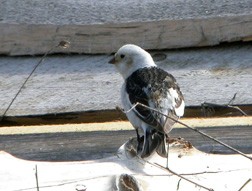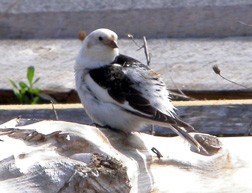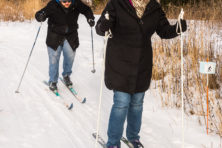Snow Bunting
- Share
- Tweet
- Pin
- Share
It was exactly 38 years ago today, November 13, 1974, that I had one of the most exciting and memorable days of field study and learning involving four different fifth grade classes that I was teaching at the Southern Door Middle School and a flock of Snow Buntings. More on that unbelievable experience later in the story…

This one Snow Bunting was photographed in late May of 2009, most likely unable to continue its northerly migration.
This year, Charlotte and I saw our first small flock of Snow Buntings on October 28. Since then hardly a day goes by without our hearing from Washington Island birders of their daily sightings of these classy little birds, usually along the old potato dock at Detroit Harbor.
The sharp, biting, September frosts had an impact on the daily activities of the Snow Buntings. One after another the small family groups of these hardy boreal birds headed south, even though weed and grass seeds were not in short supply on their nesting grounds. Strangely, they would probably encounter more unseasonable snow as they continued south into the so-called lower Arctic regions.
These plump, short-legged birds that breed farther north (83 degrees north latitude) than any other songbird, had arrived on their nesting grounds during the first half of April. As so frequently occurs in songbird populations, the males preceded the females and first-year birds. By early May, due to their being well within the “Land of the Midnight Sun,” their morning activities began as early as 1 am. Food-finding, territorial and nesting activities would occupy all but about two or three hours of each 24-hour period.
Insects, including flies, mosquitos, moths and crane flies, made up most of their summer diet. These bluebird-sized birds took on some rusty-colored feathers – the young in their post-juvenile molts, the older birds in their post-nuptial feather change. Now the adults, instead of sporting flashy black and white plumage, appeared more rusty-brown especially on the upper parts of their bodies. The young carried even more soft brown or rust coloring in their feathers. However, the undersides of their wings and bellies retained much white, making them stand out from any other small flocking songbirds of this region and unmistakable in their identification.

A side view of the May Snow Bunting
Gradually they moved southward, eating fewer insects and more seeds as the weather turned colder, their flocks increasing in size. It would be a common occurrence for Lapland Longspurs and Horned Larks to very peaceably join the flock for the duration of the winter. (Look for dark-colored birds among the next flock of Snow Buntings you see.)
It was on that exciting day, Nov. 13, 1974, that the fifth graders of Southern Door and their teachers, one class at a time, accompanied me into the school forest to learn, firsthand, about the changes taking place. Temperature below the freezing mark and a brisk wind added an unexpected sting to our walk across the broad playing field on our way to the woods. Every now and then some snowflakes landed on our eyelashes and added reality to our winter tree study.
Suddenly, unannounced, about 25 Snow Buntings took flight to the front of us. No one had noticed them, so perfectly camouflaged as they fed on weed seeds. Fortunately, they flew directly ahead of us to the baseball field where they landed on what appeared to be bare ground between second and third base.
Now began the stalking game, but only after I had instructed the students to count the number as they flew again, to look for stragglers in the flock, to try to notice the different colors of the individual birds, and to pay attention to how they flew. With all eyes glued on the birds as they fed, we approached to within about 30 feet before they took to the air.
Much to our surprise we found that thousands of short weed stalks grew where we had thought bare ground existed. Very likely the birds were feeding mainly upon the seeds of plantain. Thousands of four or five-inch stalks carpeted the infield. We were in luck as the birds landed a short distance away giving us all a chance to stalk and watch them a second time. Round and round they flew giving forth with pleasant tinkling-like trills.
The first group returned to school and I informed the second class about the possibility of seeing Snow Buntings on the way to the woods. I wondered as we stalked whether or not I should have prepared them for something they might not see, only to be thoroughly disappointed. Again luck was with us as the birds appeared almost where the last group had thrilled to their sight. Amazingly, not only did the first and second groups see them, but the third and fourth as well!
Lucky me, I was in the envied position to experience their rare treat all four times. It was for the third group that the “snowflakes,” (a favorite old name for Snow Buntings) performed so beautifully. Around and around they flew, wheeling and tumbling in their flight, singing all the while, as though wanting to get a better look at who these intruders were.

These well-camouflaged Snow Buntings, resting on a rock pile, were photographed on Dec. 27 during our Southern Door Christmas Bird Count. How many can you count? (answer is 8).
All the way home I thought to myself over and over, what a beautiful and enriching experience this had been for about 120 students, their teachers and me. Perhaps the next time they encountered a flock of birds, not necessarily Snow Buntings, they would again want the thrill of cautiously stalking them, patiently and quietly observing them and, in so doing, surely becoming a bit more reverent toward wild creatures.
Earlier-than-normal sightings of Snow Buntings, at least according to some wise old-timers, might point toward a colder winter with more snow. Some Scandinavians refer to them as hard winter birds. What we do know for sure is that these welcome birds will feast on weed and grass seeds as long as the snow does not cover the plants. The deeper the snow becomes the farther south these hardy winter vagabonds will travel, perhaps as far as southern Indiana and central Kansas.
Come late February the Snow Buntings will slowly drift back north to the longer Arctic days. We will have claimed them only briefly as “ours” while they laced the winter skies and fields with delicate songs, thrilling flights and their flashy black and white beauty.


